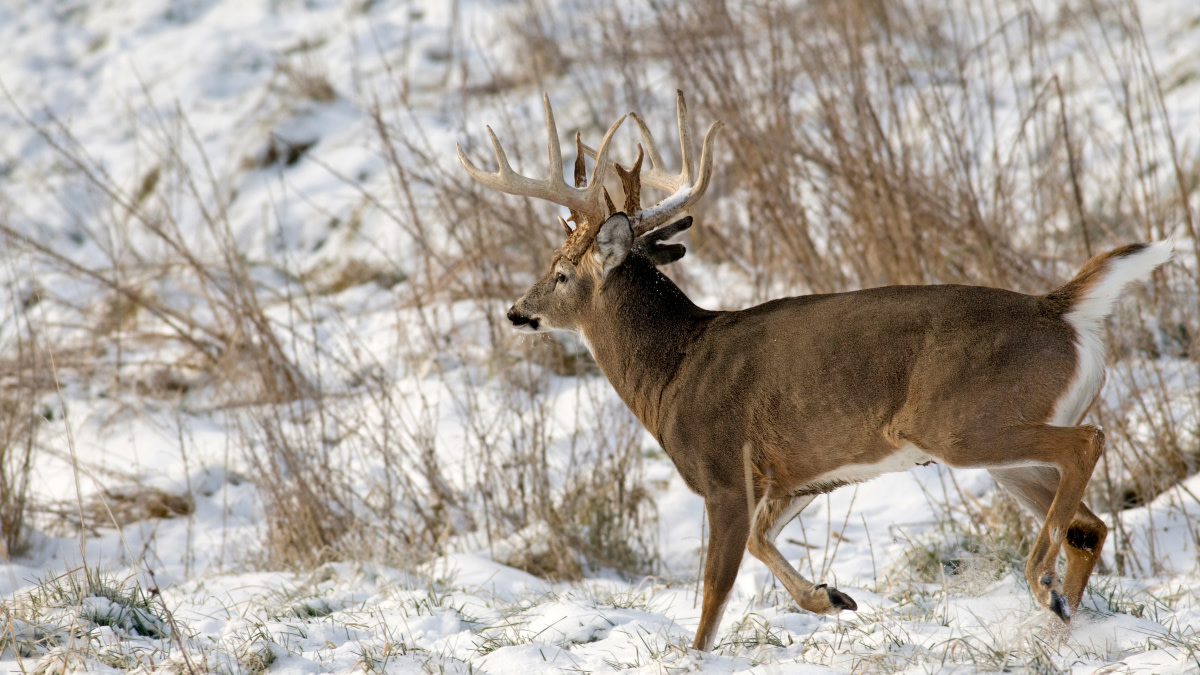
In today’s world of identity politics and serial tribalism, few things are as damning as a bad label. We all know what those sound like in the political sphere, but the same trend exists in the hunting world. Few labels are viewed with quite as much derision as “trophy hunter.”
This was brought to mind for me recently when reading a terrific article by Brody Henderson about shooting young bucks, in which he explored the disdain some hunters have received for killing young deer and the cultural phenomena that might be responsible for it. His points were valid, but the argument also brought to mind the counterpoint, which is what’s so wrong with hunting mature deer, or as some people would put it, “trophy bucks?”
In the non-hunting media, “trophy hunting” is viewed as next to demonic and is universally condemned by both animal-rights loving vegans and average, everyday Americans. While hunting in general is approved by about 79 percent of Americans, according to a Responsive Management study, that number drops to 28 percent when you add “trophy” to the question.
This distaste also exists within certain corners of the hunting community, where significant backlash is pointed towards hunters who talk about hunting “big” or “trophy” bucks—oftentimes followed by some version of “you can’t eat antlers.” This is likely, at least in part, a reaction to the young buck bashing discussed by Henderson in his aforementioned story. But there certainly is an increasing level of vitriol being leveled at hunters who choose to manage or hunt for trophy bucks as well.
As someone who chooses to hunt older and bigger bucks, I’ve had to look long and hard at my own motivations and justifications for how and why I hunt and consider what this criticism of “trophy hunting” means for me.
Several weeks ago, Henderson helped articulate the case for hunters being free to target young bucks, and I think it provided a helpful opportunity for some hunters to see things from a new perspective. I’d like to do the same for the other portion of our audience and address a few questions.
What’s wrong with shooting big, or old, or “trophy” bucks? If I do hunt for big old bucks, am I a “trophy hunter?” And if so, does that make me a prick?
Terminology
The biggest issue at play here might simply be terminology and what that terminology implies—both inside and outside the hunting community. The word “trophy” when appended with “hunter,” “bucks” or “hunting” brings with it all sorts of dirty baggage.
To most folks outside the hunting community, the word “trophy hunter” brings to mind a bloodthirsty man heartlessly killing animals for the sole purpose of placing a head or antlers on the wall and not using the meat. The word “trophy,” from this perspective, seems to imply that the hunter views an animal’s life as worth nothing more than the esteem its head might bring to the person who killed it.
Of course, most of us within the hunting community know that these assumptions are seriously flawed. I can only speak to my own experiences within the deer hunting community, but it seems safe to say that most hunters view the antlers or head of a deer they killed as an important symbol and memory of an animal and an experience. But this is only one part of why they hunt, in addition to food, challenge and outdoors adventure. The “trophy” is a physical stand-in for these other aspects, which after the food is gone and as time has passed, can still remain as a totem of those memories. To most common-sense folks, valuing antlers or a hide in no way diminishes the value of the meat or any other aspect of the animal’s life. It is merely one part of the larger whole.
Still, regardless of what most hunters understand, the trophy hunting debate is a PR battle that we are losing. “Trophy hunter” conjures up all sorts of unsavory images for the majority of the non-hunting public and I don’t see how we’ll be able to change that any time soon. Even within the hunting community, there is a growing distaste for “trophy hunting.” As discussed in Henderson’s article, there is an antler obsession within our ranks that can quickly turn negative when taken too far. For this reason, many hunters have become so disenchanted that they’ll attack “trophy hunters” just as vehemently as some folks attack young buck shooters.
There seems to be a widening divide forming between people who identify as “meat hunters” and people who identify as “trophy hunters,” and it’s becoming increasingly toxic.
If I had my druthers, we’d eliminate the terms “trophy,” “trophy hunting” and “trophy hunter” from our collective vocabulary entirely. This way of speaking about hunting is too flawed, too shallow and too divisive. We are simply hunters. And despite our unique goals and motivations, we are each just hunting.
Personal Reasons
Despite my personal desire to change the way we talk about this topic, the reality is that the “trophy hunter” moniker remains and is applied to people all the time, including myself. I primarily target bigger bucks. I enjoy watching and learning about older, wiser deer. I have shoulder mounts of big, old bucks on my wall. So does that make me a trophy hunter? And if so, is it OK to be a “trophy hunter?”
Whether it be the decision to target any deer or big deer, pulling the trigger is a personal decision. When I first started hunting, my goals were simple: killing any deer at all. Once I got the knack of that, I began to raise the bar, wanting to extend my season and increase the challenge. I’d set my new goal at targeting 3.5-year-old bucks or older, in addition to hunting does. After several years of success at that level, I found myself wanting to move the goal posts again, this time setting my target threshold at 4.5 years.
This has been and still is a personal decision based on the hunting experience I’m hoping to have. And I love hunting.
I love the long, hot days of summer preparing tree stands and scouting new properties. I love the long sits in a tree observing the wildlife around me. I love the long nights dreaming about trail camera photos and strategies for the next hunt. This process is endlessly fascinating to me. By targeting 4.5+-year-old bucks, it inevitably allows me to enjoy this process for a longer period of time and to a greater depth than if I were going to shoot the first deer I saw. There’s a unique level of engagement, detail and determination that is necessary to reach this kind of hunting goal, and that’s incredibly compelling.
But it might not be for everyone, and it shouldn’t have to be. I strongly advocate for each and every hunter to set their own goals based off their experience and opportunities. Anyone trashing another hunter’s goals—whether that be to shoot a yearling buck or a 5.5-year-old—is shooting holes and sinking our hunting community’s ship.
I’m also not ashamed to admit that, in my opinion, big-antlered, old deer are just plain cool. They are rare. They are majestic. They are beautiful. And they are survivors.
For thousands and thousands of years, humans have appreciated and revered the largest, strongest and rarest specimens of an animal species. I don’t think there is anything wrong with having that same sense of appreciation now. Can it go too far? Yes. But let’s not over-correct either.
Ecological Reasons
Over and above all else, of these personal explanations and goals, managing and hunting for big old deer in fact does encourage a whole host of larger ecological benefits, too.
The Quality Deer Management Association has been preaching this message for years, but their narrative has unfortunately been hijacked by some within the community who only care about or adhere to a small part of QDMA’s management objectives. I’m alluding, of course, to the over-obsession with big antlers, which has given the organization and its adherents a black eye. As I’ve mentioned before, I’m 100 percent aware of the downsides of going too far in this direction.
But by practicing true “quality deer management,” many positive outcomes for wildlife and hunters can be achieved. True quality deer management leads to a deer herd that is more balanced from a sex ratio and age structure standpoint, as well as in relationship with habitat. A relatively well balanced age structure and sex ratio in a deer herd—achieved by appropriate doe harvests and managing for older age class bucks—leads to healthier deer and a less stressed herd.
Take for example the effects of having a balanced buck age structure on the whitetail rut. Having higher numbers of mature bucks present during the rut leads to a short, well-timed breeding period, which then leads to a better-timed fawn drop. When the opposite situation is present, and fawn births are drawn out over a long period of time and predators can easily snatch up large numbers of fawns over the weeks-long period. On the flip side, when the rut is well-timed and short, fawns all drop during a narrow window of time—a phenomena known as “predator swamping”—leading to predators simply being unable to consume many of those fawns before they grow enough to avoid predation.
A common critique of “trophy hunters” who point to these types of benefits is that they just want to shoot big bucks, and that they’re using ecological justifications as a cover story. And, to a degree, maybe there is some truth to that. Let’s not pretend that humans aren’t inherently self-serving. Regardless, if hunting and managing for big, old deer leads to these types of positive outcomes, who cares what the original impetus was? I’d also argue that, in many cases, what might begin just as an interest in killing big deer will often grow into a desire to have a more positive impact on the larger ecosystem.
Final Thoughts
I can unequivocally say that there is nothing wrong with choosing to hunt and shoot young bucks. Criticizing anyone for doing so is not only a jackass move, but also damaging to the long-term future of our hunting lifestyle. But the same can be said for those who choose to hunt and shoot old bucks. While I might prefer this be referred to as “selective” rather than “trophy” hunting, the truth of the matter is that there are plenty of valid reasons to hunt for mature bucks that don’t point to someone being morally bankrupt.
It’s clear that differences within our hunting community can easily divide us. And if these divisions continue to grow out of control, it could spell our demise. It’s also true that our wildly unique experiences, goals and aspirations can also bring out the best in our community.
My hope is that rather than vilifying those different from ourselves, we can celebrate and lean into our diversity—each enjoying our own hunt, in our own way and with an ultimate focus on the greater good.
Feature image via John Hafner.



